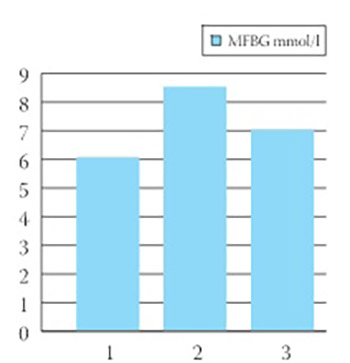Effects of Aggressive Approach to the Multiple Risk Factors for Diabetic Nephropathy on Proteinuria Reduction in Diabetes Type 2 Patients
DOI:
https://doi.org/10.17305/bjbms.2009.2855Keywords:
diabetes type 2, diabetic nephropathy, proteinuria reductionAbstract
Dietary interventions with protein and salt restriction, good glucose control, smoking cessation, aggressive blood pressure control, good control of cholesterol and triglycerides, use of ACE inhibitors and ARBs can delay the progression of diabetic nephropathy.
The aim of this study was to present the effects of aggressive treatment of the multiple risk factors for diabetic nephropathy on proteinuria in patients with type 2 diabetes. In this study we included 15 patients with diabetes type 2 and insufficient regulation of glycaemia. The patients were followed for three months period. Glycated haemoglobin (HbA1c), fasting plasma glucose (FPG), postprandial plasma glucose (PPG), blood pressure, cholesterol and triglycerides and proteinuria were followed prior and after the study. Prior the study patients were treated with premix insulin divided in two daily doses + metformin after the lunch and they had insufficient regulation of glycaemia. During the study patients were treated with one daily dose of basal insulin, three doses of metformin (2550 mg), one daily dose of atorvastatin (20 mg) and one daily dose of ramipril (5 to 10 mg). Doses of insulin were titrated separately for each patients (0,7-1,0 IU/kg). Patients were advised to start with lifestyle modification, increased physical activity and dietary interventions with protein and salt restriction, energy restricted diet and smoking cessation. A total of 20 patients (male 12 and female 8) with diabetes type 2 were studied. The mean age of the subjects was 53±5,25 years. The mean diabetes duration was 4,05±1,96 years. The mean body mass index decreased from 28,1±1,67 kg/m2 to 25,9 ±1,22 kg/m2 after the study. Mean HbA1c decreased from 8,82 ± 0,53 % to 7,15 ± 0,23 % (p<0,05). Mean fasting glycemia decreased from 8,79±0,58 mmol/dm3 to 7,03±0,18 mmol/dm3 (p < 0,05). Mean postmeal glycemia decreased from 9,93 ± 0,77 mmol/dm3 to 7,62 ± 0,42 mmol/dm3 (p<0,05). The mean cholesterol level decreased from 7,99 ±0,64 mmol/dm3 to 5,93 ± 0,65 mmol/dm3 (p<0,05). The mean triglicerides level decreased from 4,05 ± 0,97 mmol/dm3 to 1,96 ± 0,24 mmol/dm3 (p<0,05). The significant decrease of proteinuria was recorded, prior the study the mean albuminuria was 1,05 ± 0,31 g/dm3 and after the study was 0,07 ± 0,145 g/dm3 (p<0,05). Mean blood pressure prior the study was 153±8,69/91,5 ± 3,78 mm Hg (p<0,05), after the study was 125 ± 6,32/ 79,25±3,26 mmHg.
Effective control of glycaemia, blood pressure, cholesterol and triglycerides, use of ACE inhibitors, dietary interventions with protein and salt restriction, smoking cessation, can delay the progression of nephropathy in type 2 diabetes.
Downloads














